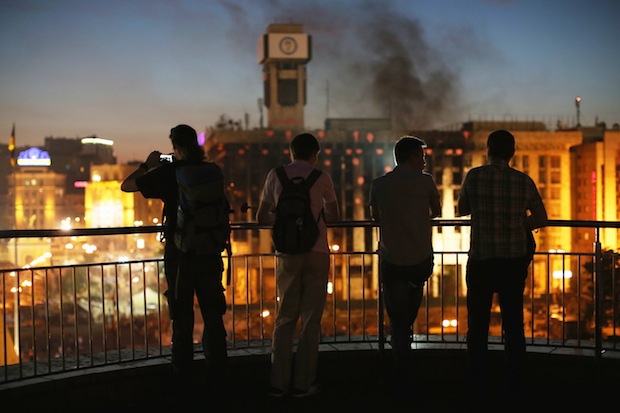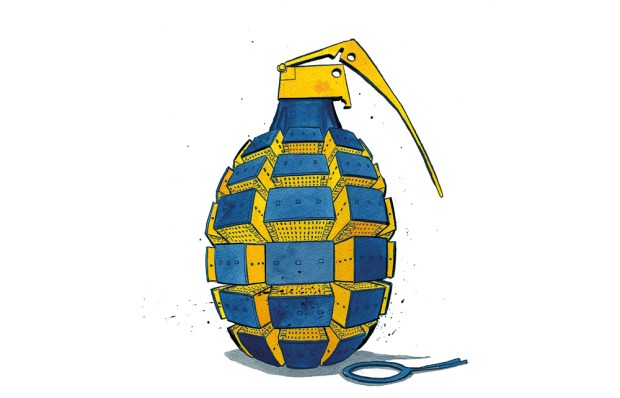Kiev
On a cobbled street above the Maidan, an elderly man dressed in fatigues rubs his stubble in the morning sunshine. Would I like a lesson in throwing Molotov cocktails? He picks up a bottle with a long wire loop for a handle, and leads me to a burnt-out public lavatory. A match to the rags stuffed in the bottle’s mouth; an overarm swing, and the bottles smashes against the far wall, flames licking round broken stalls. Would I like to pose for a photo? A young American who has stopped to watch takes up the offer. Three months after protests toppled Ukraine’s president, Viktor Yanukovych, the Maidan has turned into a tourist attraction.
The scene of the protests is still an impressive sight. Head-high, six-foot-thick barricades block off the entrances to Kiev’s main thoroughfare. Beyond, woodsmoke spills from stovepipes above a line of khaki tents, each with its Tupperware box soliciting donations ‘for the Maidan’. Souvenir stalls offer floral headbands and doormats decorated with Yanukovych’s face. There are impromptu shrines, bright with flowers and tea-lights, in memory of the hundred-odd protestors shot dead by government snipers. Flags flutter — the sky blue and wheat gold of Ukraine, and the more dubious red and black of the second world war Ukrainian Partisan Army.
Most instructive of Kiev’s new attractions is an exhibition at the National Art Gallery of items recovered from Yanukovych’s notoriously palatial suburban ‘dacha’. Spread over half a dozen rooms, it is a feast of dictator chic: a dried crocodile skin; portraits of the great man in beaten gold and amber; furniture from Baldi, an Italian firm who specialise in making bathtubs out of rock crystal and cladding pianos in malachite.
The two Baldi tables on display (one sporting dazzling winged lions, the other pointy-breasted goddesses) retail for £75,895 and £36,200. For two of several bulle-encrusted urns on show, the firm quotes £28,315 and £17,490. A Hermès ‘Cheval d’Orient’ dinner service, still wrapped? £14,800. This in a country where the president’s annual salary (post the recent collapse of the hryvnya) is £14,389, and the average wage £166 per month.
Many of the items, the exhibition’s chief curator points out, were gifts. She is reluctant to name names, for fear of ‘problems for our museum’, but lets slip that ‘a lot’ came from Rinat Akhmetov, Ukraine’s richest man and formerly a close Yanukovych associate. One of the few genuinely lovely objects on show — a Bronze Age terracotta jar, decorated with swirling spirals of grey slip — was a gift from Viktor Yushchenko, the pro-western former president. What about Petro Poroshenko, the chocolate tycoon who is Ukraine’s likely new president? She clams up: ‘Was he on the list? I don’t think so. I can’t remember.’
A dismayingly large proportion of Yanukovych’s loot was bought in London. In the first room of the exhibition, a large and hideous ormolu clock boasts a Christie’s tag, identifying it as Lot 177 in the ‘Opulent Eye’ sale held at South Kensington last September. It sold, according to the Christie’s website, for £20,000. Further on, another tag flutters from the ankle of one of a set of four fake-bronze classical statues. Lot 200 in the same sale, they fetched £265,875. From earlier Christie’s sales came an Aivazovsky seascape (June 2008; £301,250), and a Picasso vase (‘Les Danseurs’, June 2012; £265,250). The most valuable painting in the exhibition, a large religious scene by Vasiliy Polenov, went for £4.07 million (almost four times its estimate) at Bonhams in November 2011.
Asked how their wares came into the possession of Europe’s most corrupt head of state, the auction houses are unhelpful. On the Polenov, Bonhams says ‘We have no way of knowing how it arrived there.’ No twinge of embarrassment? ‘I am not free to say more than I have.’
In private, people in the business admit that turning a blind eye is the norm. According to the National Crime Agency’s latest annual report, auction houses made just 26 ‘suspicious activity reports’ between them in the year to last September — compared with more than 250,000 from the banks.
The auctioneers would point out, rightly, that they are not the only ones taking dodgy Ukrainian and Russian money. So do London’s bankers, lawyers, accountants, estate agents, interior decorators and schools. And don’t forget the garden designers: the planting round Yanukovych’s dacha is unexpectedly tasteful hostas and oak-leaf hydrangeas suggestive of a well-bred English hand. That Polenov painting shows Christ protecting a seductively dishevelled woman from a judgmental crowd. Its title? ‘He that is Without Sin, Let him Cast the First Stone’.
Got something to add? Join the discussion and comment below.
Get 10 issues for just $10
Subscribe to The Spectator Australia today for the next 10 magazine issues, plus full online access, for just $10.
You might disagree with half of it, but you’ll enjoy reading all of it. Try your first month for free, then just $2 a week for the remainder of your first year.














Comments
Don't miss out
Join the conversation with other Spectator Australia readers. Subscribe to leave a comment.
SUBSCRIBEAlready a subscriber? Log in